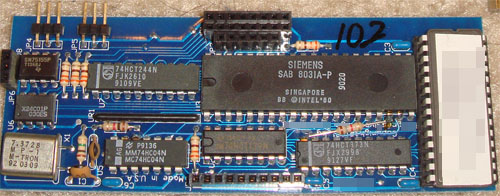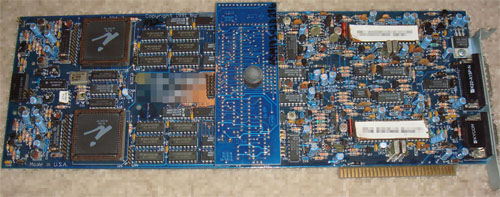The ware for June 2008 is shown below. Click on the image for a much larger version.
The flip side of the daughtercard is shown below:

Thanks to xobs for the wonderful piece of retro-Ware!
Sorry for the late posting again — I’ve been in China running around. If you ever find yourself on the way to visit the Foxconn compound near Shenzhen, I have one piece of advice for you: pack your own lunch. Until now, I’ve had pretty decent food in most of the factories I’ve visited (3CEMS actually has quite delicious food), but for some reason the food at Foxconn is awful and I’ve been ill the past two days.

I’d guess it’s a video capture card. Some on board ram, lots of analog, and even some tunable coils. I’m really surprised at the amount of analog hackery (are those copper shields over the blurred out chips?!) going on here. However, there doesn’t seem to be an appropriate RF connector anywhere. Note the 14.31818 MHz rock–isn’t that a video related frequency?
I would have though medical ultrasound imaging would require more I/O for the transducers, so I think that’s probably out.
The other weird thing is that it appears to have two channels, but why? That would seem to rule out a video capture card.
Wait–how about a two channel digitizing oscilloscope? The blurred chips could be the ADCs. Again, the connectors don’t fit the apparent bandwidth. (Besides, where’s the shielding and attenuators?)
This looks vaguely like a board to Play’s Trinity video effects and overlay system. (Play being made up of ex:NewTek employees).
Eh, scratch that – the Trinity used PCI-style card edge connectors, so this is much older than that.
I can see the end of a word to the right of the daughterboard which looks like “ogy”; perhaps the company name ends in “Technology”? Combine this with the “PIT” copyright notices and we have P.I.Technology but I couldn’t find any company matching that (though I don’t really know *how* to effectively search for possibly-defunct companies in a certain area of business).
The backplate & 31 widely spaced pins mean this is an ISA 8-bit card. The data and address pins don’t seem to be connected, but perhaps they are connected through to the other side.
The external connectors appear to be D-shell male with 9 and 15 pins. I confirmed the latter by the part no. on the inside.
The 2 big ASICs each appear to have 6 SRAM chips to the right,
possibly 4 * 4 bits + 2 * 1 bit for 16 bit bus with parity. I didn’t bother following up the part numbers for those.
The frequency of the oscillator on the main board is 14.318180 MHz whcih is 4 times the NTSC-M colour subcarrier frequency, so this is presumably video-related as Joe Bleau says.
The daughterboard has another oscillator at frequency 7.3728 MHz, which is 64 * 115200 so presumably meant for a UART. (But it might just be a cheap oscillator for a microcontroller whose speed isn’t critical.)
Relevant parts I identified (left to right more or less):
* Valor DL2171: TTL tapped delay line, 60 ns
* 14.318180 x-tal: 4 times NTSC carrier
* TI TLC5602CN: 8 bit, 30 MS/s DAC
— we can see two of them, with identical surrounding circuitry
— m’kay, so more than likely the big “i” PLCCs are driving the DACs
— actually, all the board seems to have two symmetrical halves
* 74HC595: 8 bit serial-in, (serial- and) parallel-out; 74HC298: mux
* TMS4C1050-30: probably DRAM… yes, 512 x 512 x 4 bit
* 74HC4053: analog mux, with lots of surrounding analog stuff… some coils even.
* MC34182P: dual JFET OpAmp 4MHz
* K22-A15P-N: 15 pin sub-D male connector
* “KYCON”: 9 pin or VGA-like sub-D connector
* 8 bit ISA edge connector.
I guess there are some interesting chips under that daughterboard, I can only identify 4 more ‘298 muxes.
Those two chips with mosaiced writing on the white labels are the most interesting. I can see they have a metal cover with some pins soldered to it. (you can see some more kludges around the chips, like those air-wired resistors.)
I’d guess they’re more than just simple EPROMs.
On to the daughtercard then.
* 8031 microcontroller with associated EPROM and address latch
* 7.3728 UART-friendly clock
* ‘244 buffer to talk to the mainboard
* X24C01 128 byte serial EEPROM
* SN75155 (?) RS-232 line driver and receiver — seems to go to JP4, not to the main board — debugging?
And some more kludges.
On the mainboard, you can see two traces going from the DACs to the right side of the board, running near the top and bottom edges.
So I’d guess this thing outputs monochrome video and plugs into an old ISA slot, but after looking more carefully, I see that the fingers on the ISA slot don’t connect to anything! There are three vias where the ISA ground pads would be on the other side, though.
So if there’s no data coming in through the ISA bus, it must be coming in through one of the pin headers (the 2×6 one in the middle?), or through one of the sub-D connectors.
It looks like this: , a time base corrector for the Amiga.
Arg, the link is http://www.amiga-hardware.com/showhardware.cgi?HARDID=1298
It’s an 8-bit ISA card with none of the address or data lines hooked up. Presumably they’re just using the PC for power — although looking at the vias above the connector, maybe they’re only connecting to the three GND pins on the ISA bus?
I’d also venture to say something video related. To the left of the two large chips are a DAC for each one. To the far left of the board is a delay line, but it’s short (60ns) so it’s not delaying a whole line or anything.
To the right of the big chips is a bank of TMS4C1050-30 which is “1 field×4 bit FRAM (field random-access memory)” according to US patent 5396339. Patents are the only place I’ve been able to find useful information about these chips. It seems like it’s commonly used as a frame buffer FIFO.
Why the main circuit is repeated twice I don’t know — maybe this board does some high-quality deinterlacing that would require frame buffers?
Given that it has a microcontroller as well, I wouldn’t be surprised if this is used for some basic overlay, like teleprompting or displaying other text on top of a video signal.
Wow, looks like Stern has nailed it! That was quick.
Stern: Ah, I was so close to guessing that company name! Well done.
I guess this is an inspirational lesson that you can play the game without any real hardware knowledge at all.
The memory chips and the big, square ASICs(?) scream “video”, video and 1991 screams “Amiga”, and then it’s off to the websites dedicated to chronicling every piece of Amiga hardware ever released. Feels like cheating, though.
Is it some sort of old effects/graphics processor for live television? The sort of thing they use for the lottery, news, and titles for music videos?
Since Stern was so hunble about it, I’ll say this on his behalf:
owned.
;)
I was quite impressed with how perfectly he nailed it. Bravo, sir.
Wow Stern. That was some total retro hardware recognition pwnage.
@Jesse I’d say it’s more so that you can inject the output video from the amiga in one of the input a video mixing unit by synching it with the master sync first to avoid tearing
[…] Last month we mentioned [bunnie]’s Name that Ware competition where participants try to guess the functionality of a random bit of hardware. We thought you might want to see another example; pictured above is the June 2008 ware provided by [xobs]. You can see a high res version here and an image of the daughter card as well. Be forewarned that someone has already posted the solution in the comments. At first glance there are quite a few interesting bits: board is copyright 1991, the 8-bit ISA connector doesn’t have any data lines connected, just power, and it’s got a lot of analog circuitry. Take a guess and then check out the comments on [bunnie]’s site to see the solution. […]
its the old “Kitchen Sync” by “Progressive Image Technology”
It’s a double Time Base Corrector!, It’s a “Kytchen Sync” trade mark
Foxconn?
http://ubuntu-virginia.ubuntuforums.org/showthread.php?t=869249
Hmmm….. What have we here…. Even though it seems people know what it is, I’m still going to throw in a guess.
It looks like a card my father gave me back in the mid/late ’90’s, when he worked on the imaging systems for the CNC machines that did the precision placement of ICs at an Intel plant. It appears to have either a 9 or a 25 pin connector on the bottom, and a 15 pin on the top, not to mention the many pins on the card to which I would imagine you could connect various cables, as some of them are a bit large for jumpers. Official guess, a diagnostics card for calibration of video-controlled CNC machines.
Hello
Just for your info : a TBC is a device that corrects the timing distortion that goes out of an analog video recorder (VCR).
The scanning head can be barely synced mechanically to match the output of a screen (TV).
But if you want to make editing of a video, you will need to synchronize far better.
In a typical TV studio (even a digital one today), a master signal is syncing very precisely all of the video sources and switches.
A VCR therefore needs a correction of the output timing when reading.
this is the role of a TBC.
The first one where made by ANALOG DELAY LINES ! (endless varicaps and couls, plus switching elements. I saw some of these monsters, and their digital sampling sucessors (made in 81 !) on BCN 81 & 51 recorders. Amazing !!
Hercules?
Hercules Graphics Card I mean
Cheers, great writing.
Extremely interesting post thank you for sharing I just added your website to my favorites and will be back :) By the way this is off topic but I really like your blogs layout.